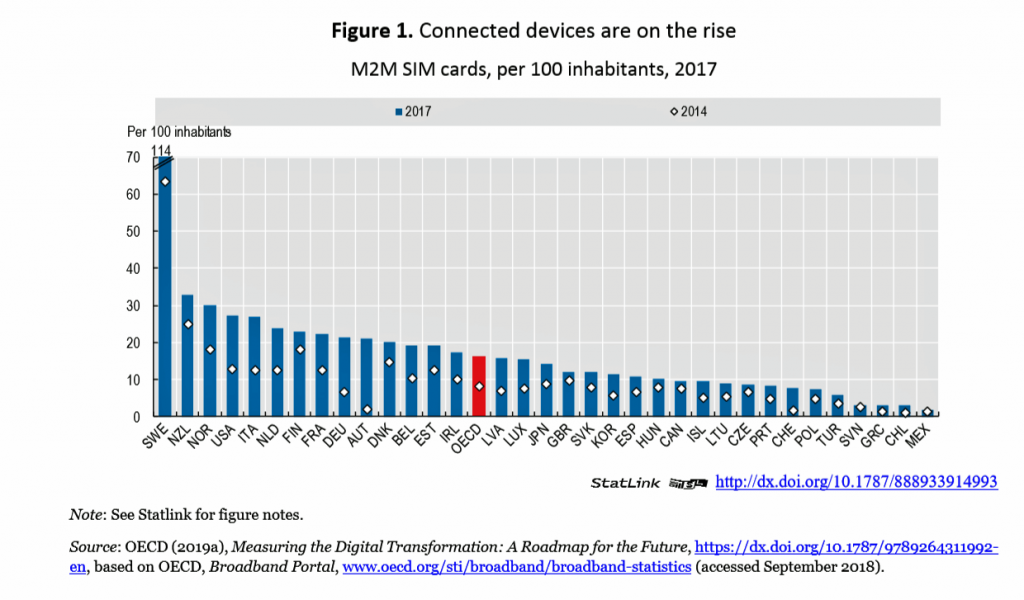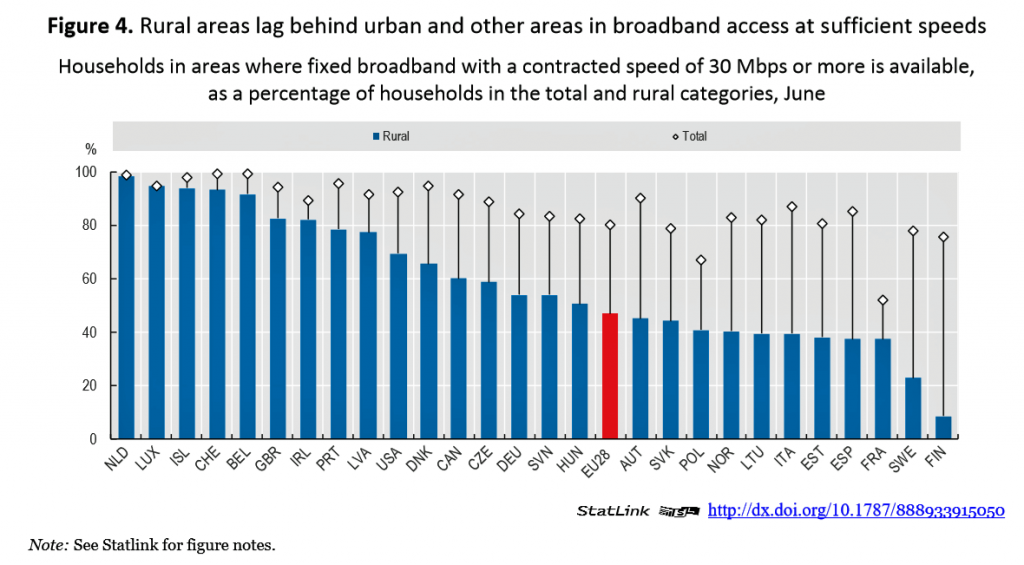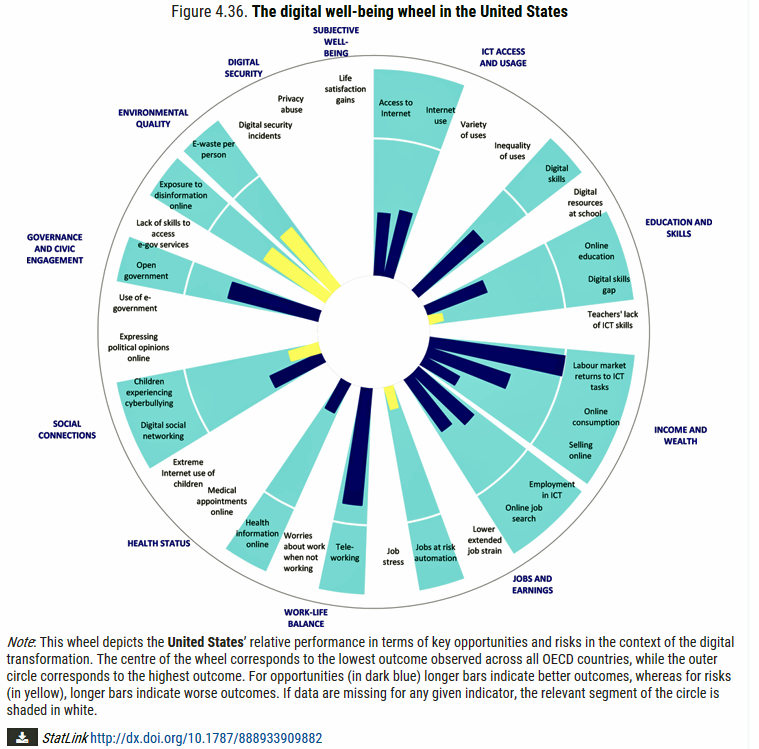
As more of our “things” get digitally connected, there’s an unanswered question about how our connected lives impact human life and health. A new report from the OECD asks and answers: How’s Life in the Digital Age? Opportunities and Risks of the Digital Transformation for People’s Well-being.
This research is part of OECD’s ongoing series asking the Big Question, “How’s Life?”
A prevailing current mantra in work and daily living is “digital transformation.” The OECD broadly defined the phrase in their 2017 paper on the topic as follows:
Mobility, cloud computing, the Internet of things (IoT), artificial intelligence (AI) and big data analytics are among the most important technologies in the digital economy today. Collectively they are enabling a future of ‘smart everything,” and empowering businesses, consumers and society as a whole.
The paper noted that at the moment, up to 30% of patents filed on medical diagnostics included AI-related components. So “digital transformation” is indeed a growing feature of modern health care.
To answer the question on digital transformation’s impact on people’s well-being, the OECD analyzed eleven aspects such as income and wealth, jobs and earnings, housing, health status, education and skills, work-life balance, civic engagement and governance, social connections, environmental quality, personal security, and subjective (self-assessed) well-being. In addition, OECD added peoples’ access to information and communication technologies (ICT) to the mix.
 Together, these elements are social determinants of health – including connectivity.
Together, these elements are social determinants of health – including connectivity.
The first bar chart illustrates the rise of connected devices across OECD nations, finding most connections in Sweden, New Zealand, and Norway, followed by the U.S.
The second bar chart shows the rural area lag in connectivity by country from another OECD report, Enhancing Access and Connectivity to Harness Digital Transformation. This and other research will be presented next week at the OECD Summit of Going Digital. Digital divides exist across gender and age within regions. But there’s also a digital divide between rural residents and their urban peers. The OECD calls this out as unequal access to broadband of sufficient quality where the share of households with broadband connections in rural areas is less than the share in urban areas — a gap that is even more significant when accounting for connection speed (which represents the quality of the connection). In 2016, 56% of rural households across the OECD community had access to fixed broadband with a minimum speed of 30 Mbps, versus 85% of households in non-rural areas. Areas with low population density, OECD asserts, can be subject to monopolies of broadband provision, as well as high-speed infrastructure gaps.

So how’s digital well-being in the U.S., anyway? The third graphic is OECD’s assessment of digital well-being in the U.S., based on the data the Organization has collected. OECD gauges America’s with “average outcomes” in attaining the potential of key opportunities of digital transformation. On the upside, the U.S. enjoys the highest returns to information and communication “tasks” in the OECD — meaning that Americans have achieved high potential income gains of digital skills. The share of U.S. population with digital skills is about average in size, and the digital skills gap is relatively small, OECD judges. But Internet access and use is below most OECD countries, and over one-fourth of U.S. households lack broadband access — the fourth lowest-share in the OECD. Exposure to disinformation is quite high compared with other countries, and 31% of Americans have encountered disinformation in the past week.
In the U.S. wheel of well-being, the long blue bars are better outcomes — for labor market returns, tele-working, digital skills, and open government.
The yellow segments are worse outcomes, for exposure to disinformation and e-waste per person.
Here’s a legend for understanding the “wheel of well-being” diagram: this shows relative performance int erms of key opportunities and risks in the context of digital transformation based on OECD’s analysis. The middle of the wheel is the lowest outcome observed across all OECD nations. The circle furthest out represents the highest outcomes. For dark blue segments, the longer the bar, the better the outcome. For the yellow, the longer bar means worse outcomes. Where there are no bars, data were missing from OECD’s data collection.
Health Populi’s Hot Points: At THINK-Health, we know that broadband connectivity is a key social determinant of both individual and community health. The OECD report on How’s Life in the Digital Age? features several pages devoted to digital connectivity bolstering more effective health care delivery. This happens in two ways: first, health care delivery improves with the adoption of electronic records, telehealth, wearable devices and sensors, and online access by health care providers. Second, health care therapies can be introduced more quickly via fast networks, OECD believes.
“However, a pre-condition for these new technologies is a trustworthy and secure infrastructure,” the report warns.
The increases availability of data can move eHealth to intelligent health, or “iHealth,” OECD states. Combining different and larger data sets can iprove care analytics and better predict risks in a population. Increased availability of health information, services and social networks online can also improve patient experiences.
The digital divide in the U.S. between rural and urban health citizens, as well as other digital gaps based on demographics like income and education, bode ill for the promise of telehealth and other aspects of digital health. Digital inclusion is key for advancing and improving health care and health care cost management in America.
The post Digital Transformation Is The New Mantra But Can’t Happen Without Access To Connectivity appeared first on HealthPopuli.com.
Digital Transformation Is The New Mantra But Can’t Happen Without Access To Connectivity posted first on http://dentistfortworth.blogspot.com
No comments:
Post a Comment